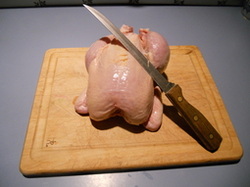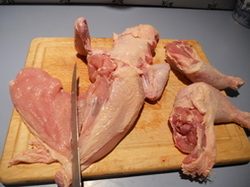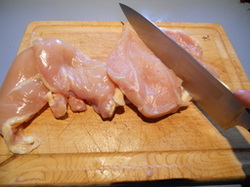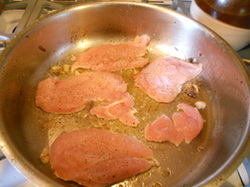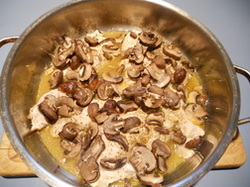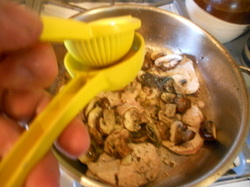|
Chicken Breasts with mushrooms was a common dish in our Italian American Kitchen. But, this dish is also found in other recipe books that might be considered more sophisticated. Here's a recipe that dates back to the traditional works of Escoffier. In his book you'll find it under "Supreme de volailles." I made only a few minor adjustments , in particular the sautéing of the mushrooms and when to add the chicken. If you know classic cook books they are nothing like those we know today. Escoffier's instructions are very general and in great part assume that the cook already knows all the details. His recipes are just a
few brief sentences. The one I'm usig here reads in the original something like, "Sautez the chicken in clarified butter, garnish with mushrooms and bake." Escoffier gives no details. Original Escoffier recipes are available online. Use a good free range pastured chicken. If you have a farmers' market in your area, that's a good source for pastured chicken. Finding a good chicken is not an easy thing. When I was a child, chicken came from 9th Street in South Philadelphia. In those days, the 9th Street market was lined with wood cages of faded gray. Inside were the chickens, alive a cackling. As children we loved to tap the cages to make them cackle even louder. At Easter time, the sellers had crates of the chicks. I imagine they sold at about ten cents each. We took home six or seven and kept them in a light warmed box in the basement. Half of them would die. But the those who survived began to outgrow thier fluffy Easter down and develop coarse, stiff feathers. They just weren't cute anymore. My father gave them to a farmer. From there, I suppose they became our Wednesday night chicken dinner. Grocerystore chickens are a world away. Chickens that are markerted as "Cage Free" are somewhat dubious. Apparently to be cage free simply means that there is a door that the chickens never use, in an otherwise overcrowded and fetid chicken coop. Just today in "Whole Foods" I was reading a label that said. "barn roaming." What does that mean? Where can a chicken roam in a barn packed to every inch with birds? Here's a video - it certainly is not faked. http://www.youtube.com/watch?v=B8BNV0oZX5M&feature=related |
These days, where chicken comes from is not something you want to know. Commercial chicken production is at the lowest level and
most vile level. If I am going to eat a flesh animal, I would like to think that the animal has been humanely raised and slaughtered. I try to buy a chicken that it "grass pastured:" a chicken that is not raised in a coop but that has been allowed to roam and scratch and forage for food. The claims of "grain fed" chickens are meaningless. Chickens do not naturally eat grains. They forage and their natural diet includes grasses and bugs. In winter, however, even pastured chickens need grain supplements. Don't be taken in by such as Perdue recent claims. Their chickens are mass produced. Recently, I have found chickens in our local Asian market that are tagged with metal clips that say "Buddhist Approved." Now, I don't know specifically what that means, but my hope is that the chicken has been humanely raised and slaughtered. For those of us who care about animals that we use as our food and they way they give their lives for our purposes, such things as their raising and their slaughter are important and difficult questions. When you buy, buy a whole chicken from a good source. For this dish, remove the breasts and save the carcass for soup and freeze the legs and wings and thighs until you have collected enough for a good curry. Serve this chicken with a nice green, like Swiss chard sautéed in garlic and olive oil and perhaps a few steamed golden potatoes. |
What you need
Plate and serve with Swiss chard or other greens and potato


